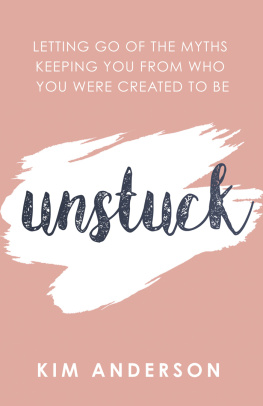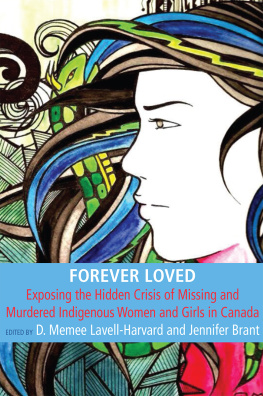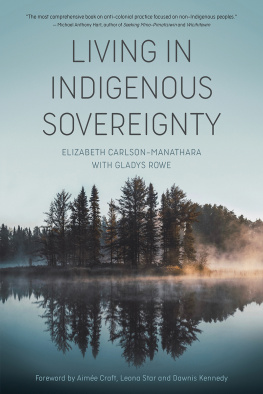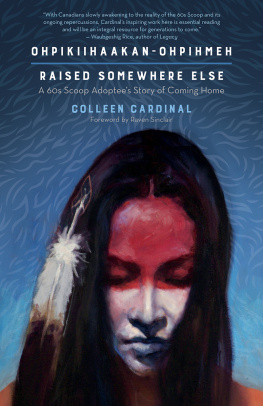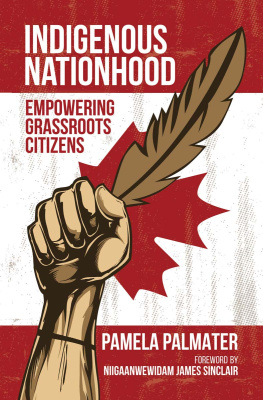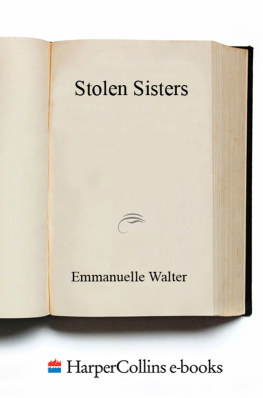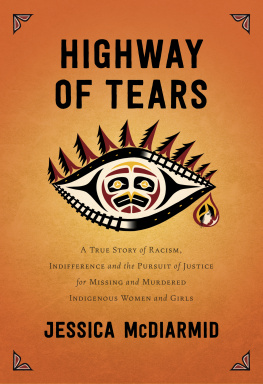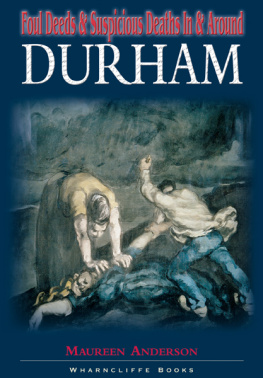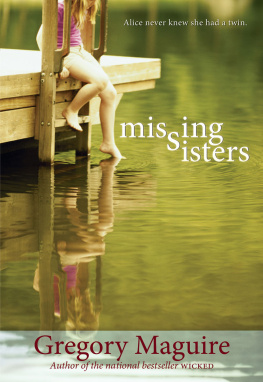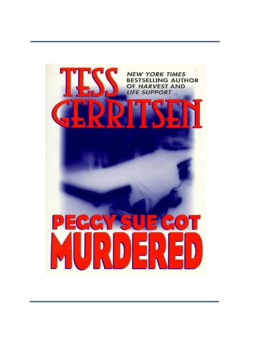
Published by
The University of Alberta Press
Ring House 2
Edmonton, Alberta, Canada T6G 2E1
www.uap.ualberta.ca
Copyright 2018 The University of Alberta Press
LIBRARY AND ARCHIVES CANADA CATALOGUING IN PUBLICATION
Keetsahnak / Our missing and murdered Indigenous sisters / Kim Anderson, Maria Campbell & Christi Belcourt, editors.
Includes bibliographical references and index.
Issued in print and electronic formats.
ISBN 9781772123678 (softcover). ISBN 9781772123913 ( EPUB ). ISBN 9781772123920 (Kindle). ISBN 9781772123906 ( PDF )
1. Native womenCrimes againstCanada. 2. Native womenCrimes againstCanadaPrevention. 3. Native womenViolence againstCanada. 4. Native womenViolence againstCanadaPrevention. 5. Missing personsCanada. 6. Murder victimsCanada. 7. Native womenCanadaSocial conditions. I. Campbell, Maria, editor II. Anderson, Kim, 1964, editor III. Belcourt, Christi, 1966, editor IV. Title: Our missing and murdered Indigenous sisters.
E98.W8K448 2018 305.48897071 | C2018901685X |
C20189016868 |
First edition, first printing, 2018.
First electronic edition, 2018.
Digital conversion by Transforma Pvt. Ltd.
Copyediting and proofreading by Joanne Muzak.
Indexing by Judy Dunlop.
Cover design by Alan Brownoff.
Cover image: Sherry Farrell Racette, She Grew Her Garden on Rough Ground , 2016, beadwork on moosehide. Used by permission
All rights reserved. No part of this publication may be reproduced, stored in a retrieval system, or transmitted in any form or by any means (electronic, mechanical, photocopying, recording, or otherwise) without prior written consent. Contact the University of Alberta Press for further details.
The University of Alberta Press supports copyright. Copyright fuels creativity, encourages diverse voices, promotes free speech, and creates a vibrant culture. Thank you for buying an authorized edition of this book and for complying with the copyright laws by not reproducing, scanning, or distributing any part of it in any form without permission. You are supporting writers and allowing the University of Alberta Press to continue to publish books for every reader.
The University of Alberta Press gratefully acknowledges the support received for its publishing program from the Government of Canada, the Canada Council for the Arts, and the Government of Alberta through the Alberta Media Fund.
Dedicated to spirits of our relatives who continue to guide their families from the spirit world.
Contents
Waking Dreams: Reflections on Walking With Our Sisters
CHRISTI BELCOURT
KIM ANDERSON
DEBRA LEO, BEATRICE STARR & STELLA AUGUST DOWNTOWN EASTSIDE POWER OF WOMEN GROUP
BEVERLY JACOBS
A Story of One Nehiyawak Family and the Power of Spirit
SANDRA LAMOUCHE
Was She Just a Dream?
ANN-MARIE LIVINGSTON & SARAH HUNT
The Historical and Sociological Context of Missing and Murdered
Indigenous Women and Girls
ROBYN BOURGEOIS
Dehumanization, Stereotyping, and Indigenous Women
MICHELLE GOOD
Gender Violence and the Legal Status of Long Island Algonquian Women
KELSEY T. LEONARD
From Indian Problem to Indian Problematic
MAYA ODEAMIK CHACABY
Stories from the Oil Fields
HELEN KNOTT
Indigenous Myths, Misses, and Misogyny
ALEX WILSON
Indigenous Men and Violence against Women
ROBERT ALEXANDER INNES & KIM ANDERSON
WAASEYAASIN CHRISTINE SY
Taking on Colonial Gender Violence in Indigenous Nation Building
LEANNE BETASAMOSAKE SIMPSON
Saskatchewan Community Activism to Address Missing and Murdered
Indigenous Women and Girls
DARLENE R. OKEMAYSIM-SICOTTE, SUSAN GINGELL &
RITA BOUVIER
PAHAN PTE SAN WIN
Anti-Violence Action and Beadwork Circles as Colonial Resistance
LAURA HARJO, JENELL NAVARRO & KIMBERLY ROBERTSON
Sitting in with Sisters
KIM ANDERSON, TRACY BEAR, CHRISTI BELCOURT, MARIA CAMPBELL, MAYA ODEAMIK CHACABY, TANYA KAPPO, TARA KAPPO, LYLA KINOSHAMEG, JO-ANNE LAWLESS, BRENDA MACDOUGALL, SYLVIA MARACLE, RAMONA REECE, MADELEINE KTSKWEW DION STOUT
Prologue
Waking Dreams: Reflections on Walking With Our Sisters
CHRISTI BELCOURT
I HAD A DREAM shortly before Walking With Our Sisters (WWOS) opened for the first time in the fall of 2013 in Edmonton. I was wondering how all those vamps were going to be set up. I knew the red cloth would be covering the floor and people would remove their shoes to walk along side the vamps. But I wasnt sure exactly how that many pairs would be laid out. I didnt yet understand the extent to which community involvement would be essential. I also didnt yet understand how this Indigenous-led commemoration was ceremony and not just art.
By the time Edmonton was set to open, 1,763 pairs of vamps had arrived, 65 beading groups had sprang up, over a dozen people had joined me on the national collective to help organize, and thousands had been inspired to express their care and concern by either making vamps, organizing to help, or making donations. It was a whirlwind and outpouring of care and compassion. We were all feeling the same way: like we needed and wanted to do something. We needed to express our support and care for the families.
In my dream, the one I had before Edmonton, I was standing in a big long lodge, the kind you see with longhouses or Midewewin lodges. There were women standing all around the edge, shoulder to shoulder. About three rows of us standing like that, looking at each other, wondering what to do. Suddenly a drum appeared in the middle, and then some men appeared and started singing. Just then, Elder Maria Campbell, who was standing beside me, walked out and began to dance with her hands faced upwards. I followed her. Other women followed as well. We all danced, hundreds of us, and then one by one everyone disappeared until I was left alone in the lodge, and I woke up.
This dream formed the basis of how the installation of WWOS is set up. The vamps are placed in pairs, one beside another, as if women are standing shoulder to shoulder in their moccasins facing the people who have come to pay their respects.
I thought, at the beginning, when I first made the call out for vamps, that WWOS was an art exhibit. It isnt. Walking With Our Sisters defies categorization. Its a commemoration, its ceremony, its an honouring, its art, its community taking action, its a way to demonstrate we care.
It is compassion that guides it. Nothing else. And it has no other purpose except for communities to come together to hold ceremony to honour the lives of missing and disappeared sisters and two-spirit loved ones, and to support family members who attend. WWOS is not an organization. Its never been registered and it will never be. Its merely a collective of caring souls.
We set no expectations or goals and allowed the ceremony to guide what needed to happen. We asked the spaces where WWOS goes to turn their space into a community-owned space. Even if it was a gallery, museum, or another type of space that is typically run by a dedicated staff, we asked that WWOS be entirely run by community and that the space become transformed into a sacred space where grandmothers, Elders, and traditional knowledge keepers could feel comfortable being there every day to sustain the ceremony.





